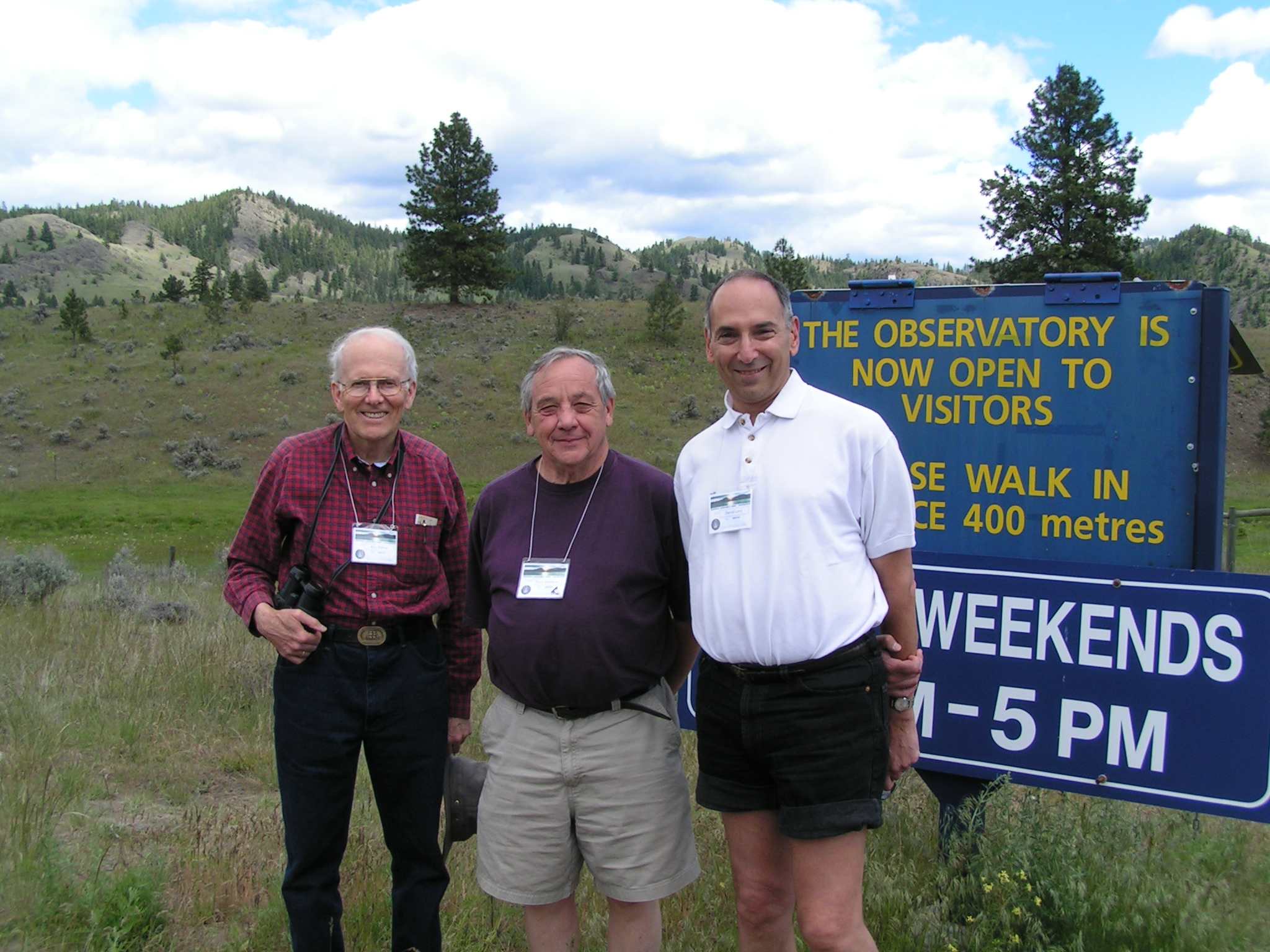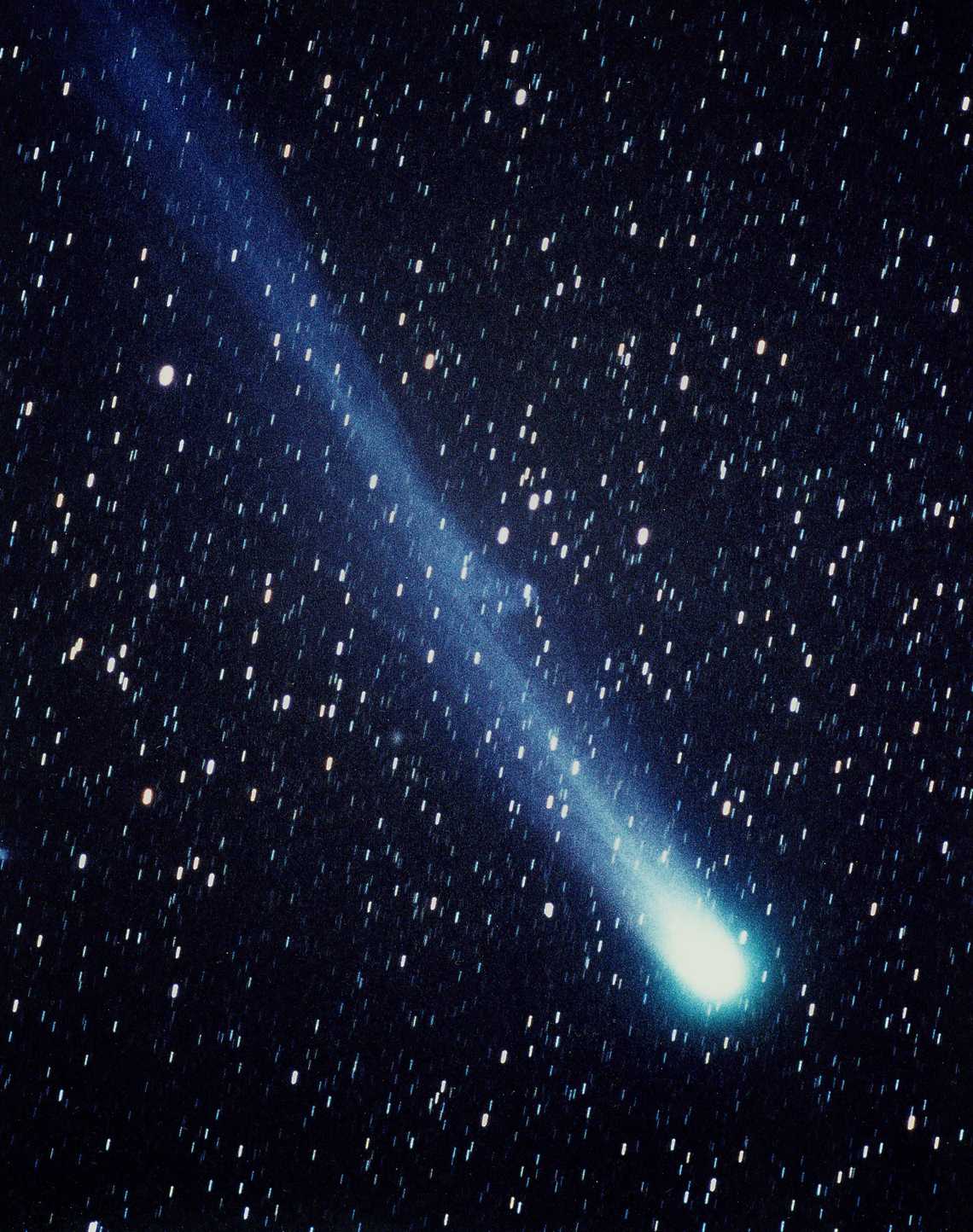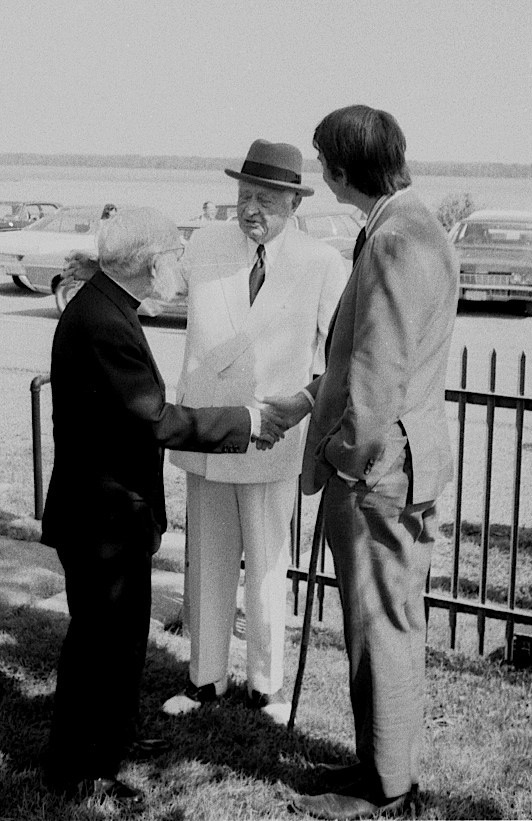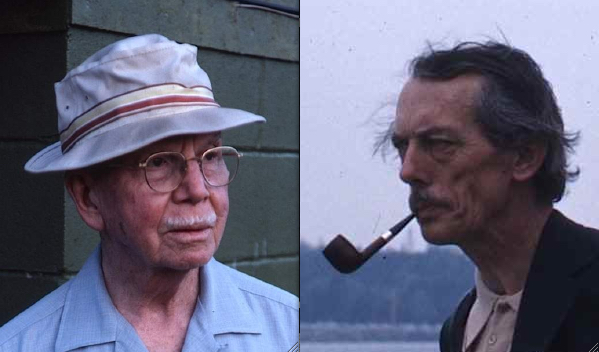A Brief History (1951-2019) by Roy Bishop
I became President of the Halifax Centre in January 1975, and Paul Gray did the same precisely 40 years later. Paul and I spoke at the 2015 January meeting on the history of the Halifax Centre. Tony Schellinck, Editor of Nova Notes at that time, asked us for a highlight report, and Paul told me to go ahead! Here is my report, updated to November 2019.
 |
◄ Paul Gray and Roy Bishop each presented their history of the Halifax RASC Centre during the January 2015 meeting. (Tony Schellinck photo) |
1951 – The Nova Scotia Astronomical Society (NSAS) was founded. Father Burke-Gaffney of St. Mary’s University was involved and became the Honorary President of the new society.
1955 January – The NSAS became the Halifax Centre of the RASC (with 30 members). Donald Crowdis, Director of the Nova Scotia Museum of Science was the central person in the Halifax Centre in the 1950s. Meetings were held in the Museum, located on Spring Garden Road, across from the old Halifax Library.
1956 – A planetarium with a Spitz model A-1projector was added to the Science Museum. On March 5 that year I sat with my grade 11 class under the planetarium dome while Crowdis gave us a show. I was impressed. The planetarium was in active use until 1965 when Crowdis left Halifax to join the proposed Ontario Science Centre.
1967 to 1970 – The Centre was not active.
It may have been a coincidence, but four remarkable astronomical events took place in the months just prior to the reappearance of the Halifax Centre:
1. The first Moon landing (1969 July 20)
2. A total solar eclipse crossed Nova Scotia (1970 March 7)
3. A bright comet: Bennett (March & April 1970)
4. A transit of Mercury (1970 May 9)
1970 – That summer, Barry Matthews re-activated the Centre by calling a meeting for September 18 at the new Nova Scotia Museum on Summer Street. In addition to Barry, among the 37 present were Father Burke-Gaffney, a student from Acadia University named David Levy, a prof from Acadia named Roy Bishop, and a teacher from the Valley, Sherman Williams. Barry Matthews moved to Ottawa shortly thereafter, but his initiative worked. The Halifax Centre was off and running.
| 1970 – That summer, Barry Matthews re-activated the Centre by calling a meeting for September 18 at the new Nova Scotia Museum on Summer Street. In addition to Barry, among the 37 present were Father Burke-Gaffney, a student from Acadia University named David Levy, a prof from Acadia named Roy Bishop, and a teacher from the Valley, Sherman Williams. Barry Matthews moved to Ottawa shortly thereafter, but his initiative worked. The Halifax Centre was off and running again. |  ▲These three gentlemen were at the first meeting of the re-activated Halifax Centre in 1970. Here, 35 years later, from left-to-right: Roy Bishop, Barry Matthews, and David Levy. (Roy Bishop photo) ▲These three gentlemen were at the first meeting of the re-activated Halifax Centre in 1970. Here, 35 years later, from left-to-right: Roy Bishop, Barry Matthews, and David Levy. (Roy Bishop photo) |
1975 – The Halifax Centre hosted the first RASC GA in Atlantic Canada.
1977 – Camping Observing Weekend (later Nova East) began.
1978? – With help from some members of the Halifax Centre, the 1956 planetarium came out of storage and began operating in the Dunn building at Dalhousie University.
1977 – Camping Observing Weekend (later Nova East) began.
1978? – With help from some members of the Halifax Centre, the 1956 planetarium came out of storage and began operating in the Dunn Building at Dalhousie University.
1980 – The Halifax Centre hosted the second RASC GA in Atlantic Canada, a joint meeting with the Canadian Astronomical Society.
1987 – Nova East established at Fundy National Park in New Brunswick.
1993 – The Halifax Centre hosted the third RASC GA. A featured speaker was the same David Levy who attended the first meeting of the re-activated Halifax Centre 23 years earlier. His topic was the anticipated collision of Comet Shoemaker-Levy 9 with Jupiter in July 1994.
1995 – Using the Saint Mary’s Burke-Gaffney Observatory, two Centre members, Paul Gray and David Lane discovered the first supernova to be found from Canada.
1995 – Lease signed with Minas Basin Pulp & Power for the St. Croix Observatory site, and forest clearing began.
1996, night of March 24/25 – At St. Croix, Comet Hyakutake provided the sight of a lifetime.
 |
◄ Comet Hyakutake on the night of 1996 March 24/25. 10 minute exposure on Ektachrome 1600 35 mm film, 100 mm, f/2.8, guided on the comet nucleus. (Roy Bishop photo) |
1997 – St. Croix Observatory (SCO) officially opened, at solar noon on the summer solstice.
1998 – Several Centre members viewed the February 26 total solar eclipse from Curacao.
1999 – Several Centre members viewed the August 11 total solar eclipse off the coast of Nova Scotia.
2000 – Nova East moved to Smileys Provincial Park in Nova Scotia.
2002 – Five Centre members (Roy Bishop, David Lane, Greg Palman, Bill Thurlow, and Mary Lou Whitehorne) spent a week observing on the summit of Mauna Kea, Hawaii, resulting in three published papers.
2009 – The International Year of Astronomy (IYA). Several Centre members were active locally and nationally with public events. The Astronomy Nova Scotia (ANS) website was created, and a radio link to astronaut Robert Thirsk on the International Space Station was part of Nova East that summer. The IYA2009 brochure (PDF), developed by RASC and ANS members, provided explanations of IYA, Astronomy Nova Scotia and the year-long program.
2010 – Kejimkujik National Park & National Historic Site became a Dark-Sky Preserve, thanks to Quinn Smith and David Chapman.
2015 – The Halifax Centre hosted the fourth RASC GA.
2016 – The 30th Nova East was held August 26, 27
2017 – Several Centre members viewed the August 21 total solar eclipse in Nebraska, U.S.A.
Leadership:
Like any volunteer organization, the Halifax Centre could not exist without members willing to step forward and lead it. Lest they be forgotten, here are the Centre Presidents and Honorary Presidents during the past 60 years:
Centre Presidents:
1955 – B.J. Edwards
1956, 1957 – James Paul
1958 – Leonard Carrigan
1959 – M.E. Higgins
1960 – ?1961 – B.W. Allen
1962 – John Connelly
1963, 1964 – A.A. Mills
1965 – Robert Bagg
1966 – Alan Whitman
1967 – 1969 – (Nil)
1970 – Barry Matthews
1971 – John Shaw
1972 – Walter Zukauskas
1973, 1974 – Murray Cunningham
1975, 1976 – Roy Bishop
1977 – David DuPuy
1978, 1979 – Michael Edwards
1980 – Randall Brooks
1981 – Peter Edwards
1983, 1984 – Kathy Oakley
1985, 1986 – Norman Scrimger
1987 – Kathy Oakley
1988 – Darren Parker
1989 – Joe Yurchesyn
1990, 1991 – Mary Lou Whitehorne
1992, 1993 – Patrick Kelly
1994, 1995 – David Lane
1996, 1997 – David Chapman
1998, 1999 – Clint Shannon
2000, 2001 – David Tindall
2002 – Mary Lou Whitehorne
2003, 2004 – Steve Tancock
2005, 2006 – Craig Levine
2007, 2008 – Paul Evans
2009 – Andrea Misner, followed by Wes Howie
2010, 2011 – Richard Vanderberg
2012 – Robert Bussières
2013, 2014 – Paul Heath
2015 – 2018 – Paul Gray
2019 – Charles White (VP)
2020 – 2022 – Judy Black
2023 – John Nangreaves
2024 – 2025 Tony McGrath
 |
◄ Halifax Centre Honorary President Father Burke-Gaffney shakes hands with Carl Sagan while Cyrus Eaton speaks to them. Wallace Bridge, Nova Scotia, 1972 July 9, one day before a total solar eclipse crossed the province. (Roy Bishop photo) |
Honorary Presidents of the Halifax Centre:
1955 – 1966, 1975 – 1979 – Father Burke-Gaffney
1980 – 1984 – Dr. William Holden
1985 – 1998 – Dr. Murray Cunningham
1998 – 2018 – Dr. Roy Bishop
2019 – 2024 – Mary Lou Whitehorne
2025 – Patrick Kelly
When Roy Bishop was appointed in 1998, he remarked to the audience: “I feel pretty good, so you might be stuck with me a long time!” After 20 years, he resigned from that position, relieved to be the first Honorary President not to die in office!
 |
◄ Halifax Centre Honorary Presidents Dr. William Holden (1980-84) on the left, and Dr. Murray Cunningham (1985-98). (Roy Bishop photos) |
Contributions to National RASC
Of the 30 RASC Centres across Canada, in terms of contributions to the National Society, the Halifax Centre has a remarkable record. Our Centre has provided three RASC Presidents, one Honorary President, two Secretaries and six Editors (one for the Journal, two for the Observer’s Calendar and three for the Observer’s Handbook). A dozen Halifax Centre members have contributed nationally in roles such as webmaster, director, assistant editor or contributing editor to the Journal, production and design of the Journal, and contributor to the Observer’s Handbook.
It is not surprising that five of the current fifteen members who have received the highest honour the national Society can pay to a member (Fellow of the Royal Astronomical Society of Canada, FRASC) are from the Halifax Centre.
Perhaps it is the Atlantic fog that is responsible for this stellar national performance.
